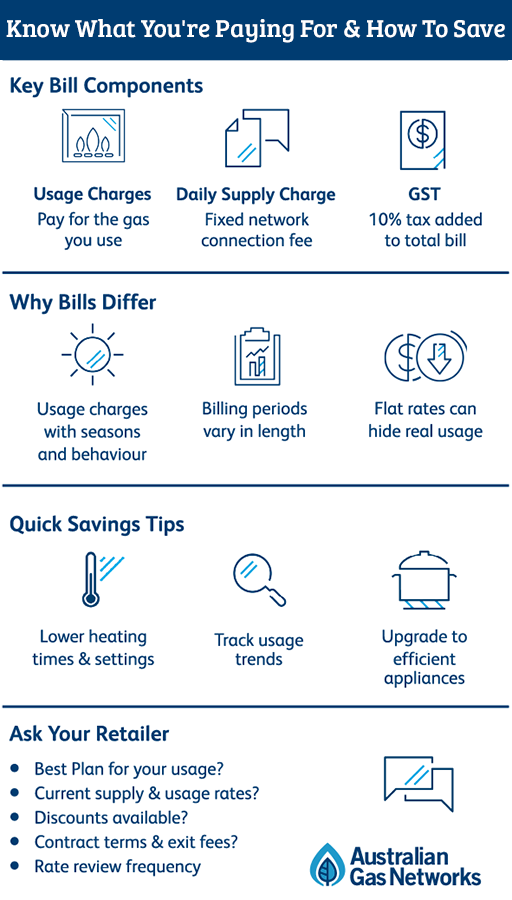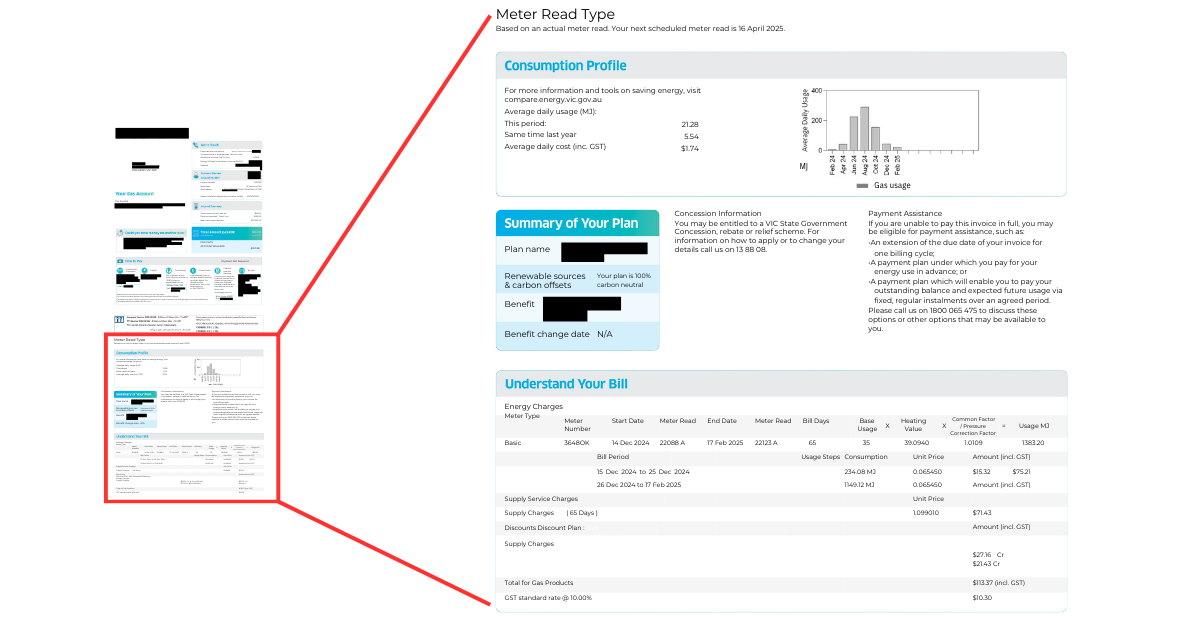If you've ever stared at your gas bill in confusion, you're not alone. Many Australian households struggle to make sense of fluctuating charges, usage figures, and varying bill layouts across retailers. Often, it feels as though costs climb without any clear explanation.
At Australian Gas Networks (AGN), we understand these frustrations. While we are responsible for safely and efficiently distributing gas to homes and businesses, we are not the retailer issuing your bill. However, understanding your gas bill can help you save money, ask the right questions, and feel more confident about your energy choices.
Key Summary
- Bill Components: Check gas bills for usage charges in MJ/m³, daily supply charge, and 10% GST across Australian households.
- Savings Potential: Some households can reduce their annual gas costs by moving from higher-priced standing offers to cheaper market offers using government comparison tools like Energy Made Easy. In certain scenarios, this can be in the order of $150–$300 per year, depending on your usage, plan type and location.
- Usage Variables: Bills vary by seasonal changes, billing periods of 28-35 days, and household behaviour patterns affecting consumption.
- Efficiency Actions: Lower thermostat settings by 1-2°C and take 3-4 minute showers to reduce daily gas usage.
 What’s on Your Gas Bill
What’s on Your Gas Bill
Understanding your gas bill starts with recognising the key components, no matter who your retailer is:
1. Usage Charges
You will see that you are charged on the amount of gas your property uses within the billing period. Depending on who you receive your bills from, this may be referred to as a “Consumption” or “Usage” charge on your bill. We will refer to this as your consumption. This is the cost of the gas you use, measured in megajoules (MJ) or cubic metres (m³). Your consumption fluctuates based on household activities, particularly heating during winter, which typically consumes the most energy in your home, regardless of whether it's gas or electric (energy.gov.au)
Factors influencing usage charges include:
- Wholesale gas prices, which can be influenced by supply, demand, the cost of production and government regulation.
- Seasonal demand and supply
- Retailer pricing structures
- Infrastructure maintenance costs
Example: Heating your home during a chilly Melbourne winter evening naturally increases your MJ consumption compared to the milder Sydney climate.
2. Daily Supply Charge
A fixed fee you pay daily to stay connected to the gas network, regardless of how much gas you use. It covers:
- Network maintenance
- Emergency response services
- Infrastructure upgrades and safety checks
Example: Even if you're away on holiday for two weeks, the daily supply charge will still apply.
3. Goods and Services Tax (GST)
A standard 10% tax added to your final bill total, as mandated by Australian taxation laws.
Why Bills Aren’t Like for Like

Bills often differ, even between neighbours using similar amounts of gas. Here’s why:
Seasonal Changes
Australian households typically consume more gas during winter due to heating requirements. Therefore, comparing your January bill with your July bill may not accurately reflect your average gas usage. Additionally, some retailers may charge different rates depending on whether gas usage occurs in winter or summer.
Different Billing Periods
Some bills may cover 28 days, others 35. More days means higher total charges, but it doesn't necessarily mean higher daily usage.
Household Behaviour
Changes such as:
- Working from home
- Hosting guests
- Going on holidays
 Comparing Gas Retailers (Without Naming Names)
Comparing Gas Retailers (Without Naming Names)

Since AGN focuses on safe gas distribution, not retailing, your retailer is responsible for setting your final costs.
Useful neutral comparison tools:
- Energy Made Easy: energymadeeasy.gov.au
- Victorian Energy Compare: compare.energy.vic.gov.au
What to Compare:
- Daily supply charge
- Usage charge per MJ or m³
- Contract terms (fixed vs variable rates)
- Discounts and conditions
- Customer service ratings
How Much Could You Save by Switching Retailers?
The 2025 St Vincent de Paul Society VIC Tariff Tracker (page 25) suggests that, in some modelled scenarios, Victorian households switching from higher-priced standing offers to competitive market plans may see estimated bill reductions in the order of $400–$1,000 per year, depending on usage, location and plan type. These savings are based on households with typical usage patterns switching from standard offers to better-value alternatives. However, individual savings depend on your current plan, annual gas consumption, and available retailer offers in your service area. We encourage you to review your current usage, contract terms and available offers to determine what's best for your circumstances and use comparison tools like Energy Made Easy to review.
To help you dive deeper, here are links to detailed energy price reports tailored to each state, offering valuable insights on local market trends and pricing:
- New South Wales (NSW): 2024 NSW Energy Prices Report (page 17)
- Australian Capital Territory (ACT): 2024 ACT Energy Prices Report (page 13)
- South Australia (SA): 2024 SA Energy Prices Report (page 14)
- Victoria (VIC): 2025 VIC Tariff Tracker (page 16)
- Queensland (QLD): 2024 QLD Energy Prices Report (page 16)
- Tasmania (TAS): 2024 Tasmanian Energy Prices Report (page 10)
Use these reports to better understand your local energy market and compare available options. When switching retailers, ensure you understand your contract terms, any exit fees, and whether you remain eligible to be connected to the gas network in your area.
All savings figures in this article are estimates based on publicly available reports and typical usage assumptions. They are general information only and do not take your specific circumstances into account. Always check current prices and plan details with your retailer or on government comparison sites before making decisions.
 Tips to Identify Where You Can Save
Tips to Identify Where You Can Save
Small adjustments can lead to significant savings over time:
Regularly Compare Retailers
Gas rates fluctuate based on market conditions. Using comparison tools ensures you are not locked into outdated pricing.
Review Your Usage Patterns
Is your winter usage double your summer usage? If so, consider:
- Sealing drafts around doors and windows
- Using zoned heating instead of whole-house heating
- Investing in heavier curtains to retain warmth
Check the Efficiency of Your Appliances
Older appliances may consume more gas. Consider upgrading to:
- 6-star energy rated heaters
- Instantaneous hot water systems
- Gas-boosted solar hot water systems
Alter Daily Habits
- Take 3–4 minute showers
- Lower thermostat settings by just 1–2°C
Comparing Heating Options
Both gas and electricity play important roles in Australia's energy system. Heating costs vary significantly by region and fuel type. Use Energy Made Easy or your state-based comparison tool to analyse the true cost of gas versus electric heating options for your specific circumstances.
Look for the Best Offer Notification
As of 2023, (Essential Services Commission) gas retailers must include a "best offer" message on your bill if you're not already on their most cost-effective plan. This makes it easier to identify potential savings without needing to ask directly.
 Questions to Ask Your Retailer
Questions to Ask Your Retailer
Empower yourself by contacting your retailer and asking:
▼ Am I on the best plan for my household's typical gas usage?
Plans vary, and your usage patterns may have changed. Asking this ensures you're not paying more than necessary.
▼ What is your current daily supply charge and usage rate per MJ or m³?
Rates differ between retailers. Knowing these charges helps you compare plans fairly and understand where most of your bill comes from.
▼ Do you offer discounts for direct debit, online billing, or bundled energy services?
These discounts can reduce your bill without changing your usage. It's worth asking if you're not already receiving them.
▼ Is there a fixed term contract and what are the exit fees?
Some plans may lock you in or charge you for switching. Understanding the terms helps you avoid unexpected costs.
▼ How often do you review your rates?
Retailers may change rates based on market conditions. Regular reviews could lead to opportunities for a better deal.
Being proactive can help you avoid unnecessary fees and ensure you're always on the most competitive plan.
Conclusion
Understanding your gas bill empowers you to:
- Know exactly what you're paying for
- Ask your retailer the right questions
- Save money through smarter usage habits
- Switch to a better plan if needed
At AGN, we are proud to deliver gas safely and efficiently to millions of homes and businesses across Australia. Now, armed with this knowledge, why not grab your latest bill, apply the tips above, and start saving today?
References
Australian Energy Regulator. (2024). Household Energy Consumption Survey. energy.gov.au Energy Made Easy. Australian Government. energymadeeasy.gov.au Victorian Energy Compare. Victorian Government. compare.energy.vic.gov.au
Essential Services Commission. esc.vic.gov.au
St Vincent de Paul Society vinnies.org.au
Important Information for Victorian Customers: As of January 1, 2024, new gas connections for dwellings in Victoria are restricted and require an approved planning permit issued before that date. New connections approved after January 1, 2025 incur an upfront installation fee (currently around $2,000, depending on your gas distributor and connection type). If you're planning a new build or require a new connection, contact your local council to determine eligibility.
All figures quoted in this article were correct at the time of publishing (June 02, 2025).






